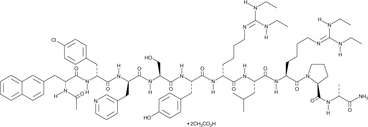Chemicals
Showing 20251–20400 of 41137 results
-
Gallic acid is a trihydroxybenzoic acid found in many plants as either the free acid or in the esterified form of gallotannins and ellagitannins. It demonstrates antioxidant activity by scavenging 2,2-diphenyl-1-picrylhydrazyl and hydroxyl free radicals with IC50 values of 9.4 and 191 μM, respectively, and inhibiting microsomal lipid peroxidation with an IC50 value of 1.51 μM.{12069} Gallic acid is often used as a standard for determining the phenol content of various analytes by the Folin-Ciocalteau assay where results are reported in gallic acid equivalents.{7686,16135}
Brand:CaymanSKU:11846 - 50 gAvailable on backorder
Gallocyanine is a small molecule blue dye used to stain nuclei. It is known to inhibit Dickkopf-1 (Dkk1), an antagonist of the Wnt pathway. Gallocyanine can disrupt the interaction of Dkk1 with its receptor LRP5/6 (IC50 = 3 µM), thereby activating Wnt/β-catenin signaling.{32876} Modulation of the Dkk1-LRP5/6 interaction via gallocyanine has been shown to inhibit prostaglandin J2-induced tau phosphorylation at serine396 in primary cortical neurons in vitro.{32876}
Brand:CaymanSKU:20657 -Available on backorder
Gallocyanine is a small molecule blue dye used to stain nuclei. It is known to inhibit Dickkopf-1 (Dkk1), an antagonist of the Wnt pathway. Gallocyanine can disrupt the interaction of Dkk1 with its receptor LRP5/6 (IC50 = 3 µM), thereby activating Wnt/β-catenin signaling.{32876} Modulation of the Dkk1-LRP5/6 interaction via gallocyanine has been shown to inhibit prostaglandin J2-induced tau phosphorylation at serine396 in primary cortical neurons in vitro.{32876}
Brand:CaymanSKU:20657 -Available on backorder
Galloflavin is an inhibitor of both the A and B isoforms of lactate dehydrogenase (Kis = 5.46 and 15.06 µM, respectively).{31860} It has been shown to prevent proliferation of many different cancer cell lines in vitro by blocking glycolysis and ATP production.{31859}
Brand:CaymanSKU:-Galloflavin is an inhibitor of both the A and B isoforms of lactate dehydrogenase (Kis = 5.46 and 15.06 µM, respectively).{31860} It has been shown to prevent proliferation of many different cancer cell lines in vitro by blocking glycolysis and ATP production.{31859}
Brand:CaymanSKU:-Galloflavin is an inhibitor of both the A and B isoforms of lactate dehydrogenase (Kis = 5.46 and 15.06 µM, respectively).{31860} It has been shown to prevent proliferation of many different cancer cell lines in vitro by blocking glycolysis and ATP production.{31859}
Brand:CaymanSKU:-Gallotannin is a polyphenol of gallic acid (Item No. 11846) that has been found in various plants and has antioxidant, anti-inflammatory, antiviral, and antiproliferative biological activities.{43122,43123,43124,43125} Gallotannin (1 μM) inhibits the intracellular production of reactive oxygen species (ROS) and DNA damage induced by phorbol 12-myristate 13-acetate (TPA; Item No. 10008014) in human polymorphonuclear neutrophils (PMNs).{43122} It also decreases TPA-induced nitric oxide release by 90% from primary rat hepatocytes when used at a concentration of 0.5 mM.{43123} Gallotannin inhibits hepatitis C virus (HCV) entry into Huh7.5 human hepatoma cells (IC50 = 5.8 μM) and inhibits the proliferation of MDA-MB-231 and MCF-7 human breast cancer cells (IC50s = 2.5 and 4 μM, respectively).{43124,43125} In a rat model of middle cerebral artery occlusion (MCAO), it increases superoxide dismutase (SOD1) protein levels and decreases the amount of proteins modified by malondialdehyde (MDA) in ischemic brain tissue when administered at a dose of 10 mg/kg.{43126}
Brand:CaymanSKU:21421 -Out of stock
Gallotannin is a polyphenol of gallic acid (Item No. 11846) that has been found in various plants and has antioxidant, anti-inflammatory, antiviral, and antiproliferative biological activities.{43122,43123,43124,43125} Gallotannin (1 μM) inhibits the intracellular production of reactive oxygen species (ROS) and DNA damage induced by phorbol 12-myristate 13-acetate (TPA; Item No. 10008014) in human polymorphonuclear neutrophils (PMNs).{43122} It also decreases TPA-induced nitric oxide release by 90% from primary rat hepatocytes when used at a concentration of 0.5 mM.{43123} Gallotannin inhibits hepatitis C virus (HCV) entry into Huh7.5 human hepatoma cells (IC50 = 5.8 μM) and inhibits the proliferation of MDA-MB-231 and MCF-7 human breast cancer cells (IC50s = 2.5 and 4 μM, respectively).{43124,43125} In a rat model of middle cerebral artery occlusion (MCAO), it increases superoxide dismutase (SOD1) protein levels and decreases the amount of proteins modified by malondialdehyde (MDA) in ischemic brain tissue when administered at a dose of 10 mg/kg.{43126}
Brand:CaymanSKU:21421 -Out of stock
Gallotannin is a polyphenol of gallic acid (Item No. 11846) that has been found in various plants and has antioxidant, anti-inflammatory, antiviral, and antiproliferative biological activities.{43122,43123,43124,43125} Gallotannin (1 μM) inhibits the intracellular production of reactive oxygen species (ROS) and DNA damage induced by phorbol 12-myristate 13-acetate (TPA; Item No. 10008014) in human polymorphonuclear neutrophils (PMNs).{43122} It also decreases TPA-induced nitric oxide release by 90% from primary rat hepatocytes when used at a concentration of 0.5 mM.{43123} Gallotannin inhibits hepatitis C virus (HCV) entry into Huh7.5 human hepatoma cells (IC50 = 5.8 μM) and inhibits the proliferation of MDA-MB-231 and MCF-7 human breast cancer cells (IC50s = 2.5 and 4 μM, respectively).{43124,43125} In a rat model of middle cerebral artery occlusion (MCAO), it increases superoxide dismutase (SOD1) protein levels and decreases the amount of proteins modified by malondialdehyde (MDA) in ischemic brain tissue when administered at a dose of 10 mg/kg.{43126}
Brand:CaymanSKU:21421 -Out of stock
Galnon is a galanin (GAL) receptor agonist (KD = 2.9 µM in Bowes cells expressing GAL1 receptors).{53507} It inhibits forskolin-induced adenylate cyclase activity in rat hippocampal membranes (EC50 = 10 µM). Galnon (2 mg/kg) reduces the maximal seizure score and increases the latency to first seizure in a mouse model of seizure induced by pentylenetetrazole (PTZ; Item No. 18682). It reduces cocaine-induced motor activity and frontal cortex, but not nucleus accumbens, dopamine overflow, as well as blocks cocaine-primed reinstatement of cocaine-seeking behavior in rats.{53508} Galnon (1.5-5 mg/kg) reduces food intake in rats and mice.{53509}
Brand:CaymanSKU:29925 - 1 mgAvailable on backorder
Galnon is a galanin (GAL) receptor agonist (KD = 2.9 µM in Bowes cells expressing GAL1 receptors).{53507} It inhibits forskolin-induced adenylate cyclase activity in rat hippocampal membranes (EC50 = 10 µM). Galnon (2 mg/kg) reduces the maximal seizure score and increases the latency to first seizure in a mouse model of seizure induced by pentylenetetrazole (PTZ; Item No. 18682). It reduces cocaine-induced motor activity and frontal cortex, but not nucleus accumbens, dopamine overflow, as well as blocks cocaine-primed reinstatement of cocaine-seeking behavior in rats.{53508} Galnon (1.5-5 mg/kg) reduces food intake in rats and mice.{53509}
Brand:CaymanSKU:29925 - 10 mgAvailable on backorder
Galnon is a galanin (GAL) receptor agonist (KD = 2.9 µM in Bowes cells expressing GAL1 receptors).{53507} It inhibits forskolin-induced adenylate cyclase activity in rat hippocampal membranes (EC50 = 10 µM). Galnon (2 mg/kg) reduces the maximal seizure score and increases the latency to first seizure in a mouse model of seizure induced by pentylenetetrazole (PTZ; Item No. 18682). It reduces cocaine-induced motor activity and frontal cortex, but not nucleus accumbens, dopamine overflow, as well as blocks cocaine-primed reinstatement of cocaine-seeking behavior in rats.{53508} Galnon (1.5-5 mg/kg) reduces food intake in rats and mice.{53509}
Brand:CaymanSKU:29925 - 25 mgAvailable on backorder
Galnon is a galanin (GAL) receptor agonist (KD = 2.9 µM in Bowes cells expressing GAL1 receptors).{53507} It inhibits forskolin-induced adenylate cyclase activity in rat hippocampal membranes (EC50 = 10 µM). Galnon (2 mg/kg) reduces the maximal seizure score and increases the latency to first seizure in a mouse model of seizure induced by pentylenetetrazole (PTZ; Item No. 18682). It reduces cocaine-induced motor activity and frontal cortex, but not nucleus accumbens, dopamine overflow, as well as blocks cocaine-primed reinstatement of cocaine-seeking behavior in rats.{53508} Galnon (1.5-5 mg/kg) reduces food intake in rats and mice.{53509}
Brand:CaymanSKU:29925 - 5 mgAvailable on backorder
Gambogic acid (GA) is a xanthonoid that has been found in G. hanburyi resin and has anticancer activity.{49693,23527,23530} It binds covalently to the regulatory subunit B (SPTSSB) of the serine palmitoyltransferase complex (Ki = 1.5 µM; kinact = 0.05 min-1) and inhibits de novo sphingolipid biosynthesis.{49693} GA activates caspases in T47D breast cancer cells (EC50 = 0.78 µM) and inhibits binding of anti-apoptotic proteins to a BH3 peptide (IC50s = 1.47, 1.21, 2.02, 0.66, 1.06, and 0.79 μM for Bcl-xL, Bcl-2, Bcl-W, Bcl-B, Bfl-1, and Mcl-1, respectively), as well as decreases the expression of Bcl-2 and increases the expression of Bax in MGC-803 human gastric carcinoma cells.{23529,23528,23526} GA binds to the transferrin receptor (IC50 = 4.1 µM), reduces growth of a variety of cancer cell lines (GI50s = 0.115-1 µM), and induces apoptosis in T47D cells.{23527} It also inhibits growth of U87 glioma cells, as well as increases the levels of leucine-rich repeats and immunoglobulin-like domains protein 1 (LRIG1), decreases the levels of EGFR, and reduces Akt/mTORC1 signaling in these cells.{23530} GA inhibits the chymotrypsin activity of the 20S proteasome in a dose-dependent manner and is a slow inhibitor of inward-rectifying potassium channel 2.1 (Kir2.1; IC50 = <0.1 µM).{23531,23524}
Brand:CaymanSKU:-Gambogic acid (GA) is a xanthonoid that has been found in G. hanburyi resin and has anticancer activity.{49693,23527,23530} It binds covalently to the regulatory subunit B (SPTSSB) of the serine palmitoyltransferase complex (Ki = 1.5 µM; kinact = 0.05 min-1) and inhibits de novo sphingolipid biosynthesis.{49693} GA activates caspases in T47D breast cancer cells (EC50 = 0.78 µM) and inhibits binding of anti-apoptotic proteins to a BH3 peptide (IC50s = 1.47, 1.21, 2.02, 0.66, 1.06, and 0.79 μM for Bcl-xL, Bcl-2, Bcl-W, Bcl-B, Bfl-1, and Mcl-1, respectively), as well as decreases the expression of Bcl-2 and increases the expression of Bax in MGC-803 human gastric carcinoma cells.{23529,23528,23526} GA binds to the transferrin receptor (IC50 = 4.1 µM), reduces growth of a variety of cancer cell lines (GI50s = 0.115-1 µM), and induces apoptosis in T47D cells.{23527} It also inhibits growth of U87 glioma cells, as well as increases the levels of leucine-rich repeats and immunoglobulin-like domains protein 1 (LRIG1), decreases the levels of EGFR, and reduces Akt/mTORC1 signaling in these cells.{23530} GA inhibits the chymotrypsin activity of the 20S proteasome in a dose-dependent manner and is a slow inhibitor of inward-rectifying potassium channel 2.1 (Kir2.1; IC50 = <0.1 µM).{23531,23524}
Brand:CaymanSKU:-Gambogic acid (GA) is a xanthonoid that has been found in G. hanburyi resin and has anticancer activity.{49693,23527,23530} It binds covalently to the regulatory subunit B (SPTSSB) of the serine palmitoyltransferase complex (Ki = 1.5 µM; kinact = 0.05 min-1) and inhibits de novo sphingolipid biosynthesis.{49693} GA activates caspases in T47D breast cancer cells (EC50 = 0.78 µM) and inhibits binding of anti-apoptotic proteins to a BH3 peptide (IC50s = 1.47, 1.21, 2.02, 0.66, 1.06, and 0.79 μM for Bcl-xL, Bcl-2, Bcl-W, Bcl-B, Bfl-1, and Mcl-1, respectively), as well as decreases the expression of Bcl-2 and increases the expression of Bax in MGC-803 human gastric carcinoma cells.{23529,23528,23526} GA binds to the transferrin receptor (IC50 = 4.1 µM), reduces growth of a variety of cancer cell lines (GI50s = 0.115-1 µM), and induces apoptosis in T47D cells.{23527} It also inhibits growth of U87 glioma cells, as well as increases the levels of leucine-rich repeats and immunoglobulin-like domains protein 1 (LRIG1), decreases the levels of EGFR, and reduces Akt/mTORC1 signaling in these cells.{23530} GA inhibits the chymotrypsin activity of the 20S proteasome in a dose-dependent manner and is a slow inhibitor of inward-rectifying potassium channel 2.1 (Kir2.1; IC50 = <0.1 µM).{23531,23524}
Brand:CaymanSKU:-Gambogic acid (GA) is a xanthonoid that has been found in G. hanburyi resin and has anticancer activity.{49693,23527,23530} It binds covalently to the regulatory subunit B (SPTSSB) of the serine palmitoyltransferase complex (Ki = 1.5 µM; kinact = 0.05 min-1) and inhibits de novo sphingolipid biosynthesis.{49693} GA activates caspases in T47D breast cancer cells (EC50 = 0.78 µM) and inhibits binding of anti-apoptotic proteins to a BH3 peptide (IC50s = 1.47, 1.21, 2.02, 0.66, 1.06, and 0.79 μM for Bcl-xL, Bcl-2, Bcl-W, Bcl-B, Bfl-1, and Mcl-1, respectively), as well as decreases the expression of Bcl-2 and increases the expression of Bax in MGC-803 human gastric carcinoma cells.{23529,23528,23526} GA binds to the transferrin receptor (IC50 = 4.1 µM), reduces growth of a variety of cancer cell lines (GI50s = 0.115-1 µM), and induces apoptosis in T47D cells.{23527} It also inhibits growth of U87 glioma cells, as well as increases the levels of leucine-rich repeats and immunoglobulin-like domains protein 1 (LRIG1), decreases the levels of EGFR, and reduces Akt/mTORC1 signaling in these cells.{23530} GA inhibits the chymotrypsin activity of the 20S proteasome in a dose-dependent manner and is a slow inhibitor of inward-rectifying potassium channel 2.1 (Kir2.1; IC50 = <0.1 µM).{23531,23524}
Brand:CaymanSKU:-Gamithromycin is an antibiotic that is active against macrolide-resistant R. equi and S. zooepidemicus (MIC90s = 1 and 0.125 μg/ml, respectively).{36243} It reduces the number of pneumonic lesions in a bovine M. haemolytica challenge model at a dose of 6 mg/kg.{36244} Formulations containing gamithromycin have been used to treat bovine respiratory diseases.{36245}
Brand:CaymanSKU:23389 - 10 mgAvailable on backorder
Gamithromycin is an antibiotic that is active against macrolide-resistant R. equi and S. zooepidemicus (MIC90s = 1 and 0.125 μg/ml, respectively).{36243} It reduces the number of pneumonic lesions in a bovine M. haemolytica challenge model at a dose of 6 mg/kg.{36244} Formulations containing gamithromycin have been used to treat bovine respiratory diseases.{36245}
Brand:CaymanSKU:23389 - 100 mgAvailable on backorder
Gamithromycin is an antibiotic that is active against macrolide-resistant R. equi and S. zooepidemicus (MIC90s = 1 and 0.125 μg/ml, respectively).{36243} It reduces the number of pneumonic lesions in a bovine M. haemolytica challenge model at a dose of 6 mg/kg.{36244} Formulations containing gamithromycin have been used to treat bovine respiratory diseases.{36245}
Brand:CaymanSKU:23389 - 25 mgAvailable on backorder
Gamithromycin is an antibiotic that is active against macrolide-resistant R. equi and S. zooepidemicus (MIC90s = 1 and 0.125 μg/ml, respectively).{36243} It reduces the number of pneumonic lesions in a bovine M. haemolytica challenge model at a dose of 6 mg/kg.{36244} Formulations containing gamithromycin have been used to treat bovine respiratory diseases.{36245}
Brand:CaymanSKU:23389 - 50 mgAvailable on backorder
Ganaxolone is a 3β-methylated synthetic analog of the neurosteroid allopregnanolone that allosterically enhances GABAA receptor current.{32575,28852} At nanomolar concentrations, it can potentiate GABA-evoked currents at GABAA receptor complexes containing α1, α2, α3, β2, and γ2L subunits expressed in Xenopus oocytes.{32575,28852} Ganaxolone has been shown to have a broad range of antiseizure activity in animal epilepsy models and human clinical trials.{30563,27521,29670}
Brand:CaymanSKU:20919 -Out of stock
Ganaxolone is a 3β-methylated synthetic analog of the neurosteroid allopregnanolone that allosterically enhances GABAA receptor current.{32575,28852} At nanomolar concentrations, it can potentiate GABA-evoked currents at GABAA receptor complexes containing α1, α2, α3, β2, and γ2L subunits expressed in Xenopus oocytes.{32575,28852} Ganaxolone has been shown to have a broad range of antiseizure activity in animal epilepsy models and human clinical trials.{30563,27521,29670}
Brand:CaymanSKU:20919 -Out of stock
Ganaxolone is a 3β-methylated synthetic analog of the neurosteroid allopregnanolone that allosterically enhances GABAA receptor current.{32575,28852} At nanomolar concentrations, it can potentiate GABA-evoked currents at GABAA receptor complexes containing α1, α2, α3, β2, and γ2L subunits expressed in Xenopus oocytes.{32575,28852} Ganaxolone has been shown to have a broad range of antiseizure activity in animal epilepsy models and human clinical trials.{30563,27521,29670}
Brand:CaymanSKU:20919 -Out of stock
Ganaxolone is a 3β-methylated synthetic analog of the neurosteroid allopregnanolone that allosterically enhances GABAA receptor current.{32575,28852} At nanomolar concentrations, it can potentiate GABA-evoked currents at GABAA receptor complexes containing α1, α2, α3, β2, and γ2L subunits expressed in Xenopus oocytes.{32575,28852} Ganaxolone has been shown to have a broad range of antiseizure activity in animal epilepsy models and human clinical trials.{30563,27521,29670}
Brand:CaymanSKU:20919 -Out of stock
Ganciclovir is a synthetic analog of 2′-deoxy-guanosine which is used to treat or prevent cytomegalovirus (CMV) infections.{22178,22179} It inhibits the replication of human CMV with an IC50 value of 0.01 μM and is effective against strains of CMV from human, monkey, mouse, and guinea pig.{22181,22180}
Brand:CaymanSKU:-Ganciclovir is a synthetic analog of 2′-deoxy-guanosine which is used to treat or prevent cytomegalovirus (CMV) infections.{22178,22179} It inhibits the replication of human CMV with an IC50 value of 0.01 μM and is effective against strains of CMV from human, monkey, mouse, and guinea pig.{22181,22180}
Brand:CaymanSKU:-Ganciclovir is a synthetic analog of 2′-deoxy-guanosine which is used to treat or prevent cytomegalovirus (CMV) infections.{22178,22179} It inhibits the replication of human CMV with an IC50 value of 0.01 μM and is effective against strains of CMV from human, monkey, mouse, and guinea pig.{22181,22180}
Brand:CaymanSKU:-Ganciclovir-d5 is intended for use as an internal standard for the quantification of ganciclovir (Item No. 13853) by GC- or LC-MS. Ganciclovir is a synthetic analog of 2’-deoxy-guanosine that inhibits the replication of human cytomegalovirus (CMV) with an IC50 value of 0.01 μM.{22181,22180} It is effective against strains of CMV from human, monkey, mouse, and guinea pig.{22181,22180} Formulations containing ganciclovir have been used to treat or prevent CMV infections.{22178,22179}
Brand:CaymanSKU:22565 -Out of stock
Ganciclovir-d5 is intended for use as an internal standard for the quantification of ganciclovir (Item No. 13853) by GC- or LC-MS. Ganciclovir is a synthetic analog of 2’-deoxy-guanosine that inhibits the replication of human cytomegalovirus (CMV) with an IC50 value of 0.01 μM.{22181,22180} It is effective against strains of CMV from human, monkey, mouse, and guinea pig.{22181,22180} Formulations containing ganciclovir have been used to treat or prevent CMV infections.{22178,22179}
Brand:CaymanSKU:22565 -Out of stock
Ganglioside GD1a is a sialic acid-containing glycosphingolipid that has been found in brain, erythrocytes, bone marrow, testis, spleen, and liver, as well as in serum lipoproteins.{54332,54333} It is shed into the tumor microenvironment from the surface of tumor cells, where it influences tumor-host cell interactions to promote tumor cell proliferation, invasion, and metastasis.{25490} It functions as a toll-like receptor 2 (TLR2) co-receptor in isolated human monocytes, colocalizing with TLR2 and enhancing the binding of type IIb E. coli enterotoxin (LT-IIb-B5) to TLR2 when used at a concentration of 20 µM.{25484} Ganglioside GD1a (20 µM) increases VEGF-induced proliferation of human umbilical vein endothelial cells (HUVECs), as well as induces vascularization in a Matrigel™ plug assay in mice when used at a concentration of 20 µM/plug.{25490} It accumulates in the CNS of patients with galactosialidosis, a lysosomal storage disorder.{43703} Ganglioside GD1a mixture contains ganglioside GD1a molecular species with C14:0, C16:0, C18:0, C20:0, and C22:0 fatty acyl chains. [Matreya, LLC. Catalog No. 1062]
Brand:CaymanSKU:31591 - 5 mgAvailable on backorder
Ganglioside GD1a is a sialic acid-containing glycosphingolipid found in brain, erythrocytes, bone marrow, testis, spleen, and liver.{25490} It can be shed from the surface of tumor cells into the microenvironment where it influences tumor-host cell interactions to promote tumor cell proliferation, invasion, and metastasis. Ganglioside GD1a (20 μM) also increases endothelial cell proliferation. Furthermore, ganglioside GD1a has been shown to act as a functional coreceptor for toll-like receptor 2 (TLR2), enabling the recruitment of TLR2 to lipid rafts when bound by a bacterial toxin.{25484} Ganglioside GD1a mixture contains porcine ganglioside GD1a molecular species with primarily C18:0 fatty acyl chain lengths, as well as a lower amount of C20:0 fatty acyl chain lengths, among various others.[Matreya, LLC. Catalog No. 1546]
Brand:CaymanSKU:31707 - 1 mgAvailable on backorder
Ganglioside GD1a is a sialic acid-containing glycosphingolipid found in brain, erythrocytes, bone marrow, testis, spleen, and liver.{25490} It can be shed from the surface of tumor cells into the microenvironment where it influences tumor-host cell interactions to promote tumor cell proliferation, invasion, and metastasis. Ganglioside GD1a (20 μM) also increases endothelial cell proliferation. Furthermore, ganglioside GD1a has been shown to act as a functional coreceptor for toll-like receptor 2 (TLR2), enabling the recruitment of TLR2 to lipid rafts when bound by a bacterial toxin.{25484} Ganglioside GD1a mixture contains porcine ganglioside GD1a molecular species with primarily C18:0 fatty acyl chain lengths, as well as a lower amount of C20:0 fatty acyl chain lengths, among various others.[Matreya, LLC. Catalog No. 1546]
Brand:CaymanSKU:31707 - 10 mgAvailable on backorder
Ganglioside GD1a is a sialic acid-containing glycosphingolipid found in brain, erythrocytes, bone marrow, testis, spleen, and liver.{25490} It can be shed from the surface of tumor cells into the microenvironment where it influences tumor-host cell interactions to promote tumor cell proliferation, invasion, and metastasis. Ganglioside GD1a (20 μM) also increases endothelial cell proliferation. Furthermore, ganglioside GD1a has been shown to act as a functional coreceptor for toll-like receptor 2 (TLR2), enabling the recruitment of TLR2 to lipid rafts when bound by a bacterial toxin.{25484} Ganglioside GD1a mixture contains porcine ganglioside GD1a molecular species with primarily C18:0 fatty acyl chain lengths, as well as a lower amount of C20:0 fatty acyl chain lengths, among various others.[Matreya, LLC. Catalog No. 1546]
Brand:CaymanSKU:31707 - 5 mgAvailable on backorder
Ganglioside GD1a is a sialic acid-containing glycosphingolipid found in brain, erythrocytes, bone marrow, testis, spleen, and liver.{25490} It can be shed from the surface of tumor cells into the microenvironment where it influences tumor-host cell interactions to promote tumor cell proliferation, invasion, and metastasis. Ganglioside GD1a (20 μM) also increases endothelial cell proliferation. Furthermore, ganglioside GD1a has been shown to act as a functional coreceptor for toll-like receptor 2 (TLR2), enabling the recruitment of TLR2 to lipid rafts when bound by a bacterial toxin.{25484} Ganglioside GD1a mixture contains ganglioside GD1a molecular species with C18:1 and C20:1 sphingoid backbones.
Brand:CaymanSKU:-Ganglioside GD1a is a sialic acid-containing glycosphingolipid found in brain, erythrocytes, bone marrow, testis, spleen, and liver.{25490} It can be shed from the surface of tumor cells into the microenvironment where it influences tumor-host cell interactions to promote tumor cell proliferation, invasion, and metastasis. Ganglioside GD1a (20 μM) also increases endothelial cell proliferation. Furthermore, ganglioside GD1a has been shown to act as a functional coreceptor for toll-like receptor 2 (TLR2), enabling the recruitment of TLR2 to lipid rafts when bound by a bacterial toxin.{25484} Ganglioside GD1a mixture contains ganglioside GD1a molecular species with C18:1 and C20:1 sphingoid backbones.
Brand:CaymanSKU:-Ganglioside GD1b is an acidic glycosphingolipid that contains two sialic acid residues linked to an inner galactose unit. It is a component of plasma membranes where it packs densely with cholesterol to form lipid microdomains that modulate both intra- and intercellular signaling events.{31218} The concentration of ganglioside GD1b in human brain increases with age, constituting 7.85% of total sialic acid in the brain of 0- to 10-year-old subjects and 20.29% in 11- to 30-year-old subjects.{31219} Ganglioside GD1b levels are positively correlated with pilocytic astrocytoma tumor grade, and GD1b has been detected in various other gliomas, including primitive neuroectodermal tumors, glioblastomas, and anaplastic astrocytomas.{54530} Ganglioside GD1b mixture contains ganglioside GD1b molecular species isolated from bovine brain with primarily C18:0 fatty acyl chain lengths. [Matreya, LLC. Catalog No. 1501]
Brand:CaymanSKU:31708 - 1 mgAvailable on backorder
Ganglioside GD1b is an acidic glycosphingolipid that contains two sialic acid residues linked to an inner galactose unit. It is a component of plasma membranes where it packs densely with cholesterol to form lipid microdomains that modulate both intra- and intercellular signaling events.{31218} The concentration of ganglioside GD1b in human brain increases with age, constituting 7.85% of total sialic acid in the brain of 0- to 10-year-old subjects and 20.29% in 11- to 30-year-old subjects.{31219} Ganglioside GD1b levels are positively correlated with pilocytic astrocytoma tumor grade, and GD1b has been detected in various other gliomas, including primitive neuroectodermal tumors, glioblastomas, and anaplastic astrocytomas.{54530} Ganglioside GD1b mixture contains ganglioside GD1b molecular species isolated from bovine brain with primarily C18:0 fatty acyl chain lengths. [Matreya, LLC. Catalog No. 1501]
Brand:CaymanSKU:31708 - 5 mgAvailable on backorder
Ganglioside GD1b is an acidic glycosphingolipid that contains two sialic acid residues linked to an inner galactose unit. It is a component of plasma membranes where it packs densely with cholesterol to form lipid microdomains that modulate both intra- and intercellular signaling events.{31218} The concentration of ganglioside GD1b in human brain increases with age, constituting 7.85% of total sialic acid in the brain of 0- to 10-year-old subjects and 20.29% in 11- to 30-year-old subjects.{31219} Ganglioside GD1b levels are positively correlated with pilocytic astrocytoma tumor grade, and GD1b has been detected in various other gliomas, including primitive neuroectodermal tumors, glioblastomas, and anaplastic astrocytomas.{54530} Ganglioside GD1b mixture contains ganglioside GD1b molecular species isolated from porcine brain with primarily C18:0 fatty acyl chain lengths, as well as a lower amount of C20:0 fatty acyl chain lengths, among various others. [Matreya, LLC. Catalog No. 1547]
Brand:CaymanSKU:31593 - 1 mgAvailable on backorder
Ganglioside GD1b is an acidic glycosphingolipid that contains two sialic acid residues linked to an inner galactose unit. It is a component of plasma membranes where it packs densely with cholesterol to form lipid microdomains that modulate both intra- and intercellular signaling events.{31218} The concentration of ganglioside GD1b in human brain increases with age, constituting 7.85% of total sialic acid in the brain of 0- to 10-year-old subjects and 20.29% in 11- to 30-year-old subjects.{31219} Ganglioside GD1b levels are positively correlated with pilocytic astrocytoma tumor grade, and GD1b has been detected in various other gliomas, including primitive neuroectodermal tumors, glioblastomas, and anaplastic astrocytomas.{54530} Ganglioside GD1b mixture contains ganglioside GD1b molecular species isolated from porcine brain with primarily C18:0 fatty acyl chain lengths, as well as a lower amount of C20:0 fatty acyl chain lengths, among various others. [Matreya, LLC. Catalog No. 1547]
Brand:CaymanSKU:31593 - 5 mgAvailable on backorder
Ganglioside GD1b is an acidic glycosphingolipid that contains two sialic acid residues linked to an inner galactose unit. It is a component of plasma membranes where it packs densely with cholesterol to form lipid microdomains that modulate both intra- and intercellular signaling events.{31218} The concentration of ganglioside GD1b in human brain increases with age, constituting 7.85% of total sialic acid in the brain of 0- to 10-year-old subjects and 20.29% in 11- to 30-year-old subjects.{31219} Ganglioside GD1b levels are positively correlated with pilocytic astrocytoma tumor grade, and GD1b has been detected in various other gliomas, including primitive neuroectodermal tumors, glioblastomas, and anaplastic astrocytomas.{54530} Ganglioside GD1b mixture contains ganglioside GD1b molecular species with C18:1 and C20:1 fatty acyl chains.
Brand:CaymanSKU:-Available on backorder
Ganglioside GD3 is synthesized by the addition of two sialic acid residues to lactosylceramide and can serve as a precursor to the formation of more complex gangliosides by the action of glycosyl- and sialyltransferases.{31218} It induces apoptosis in HuT-78 cutaneous T cell lymphoma cells in a concentration-dependent manner and disrupts the mitochondrial membrane potential when used at a concentration of 200 μM.{5033} Expression of ganglioside GD3 in GD3-negative SK-MEL-28-N1 malignant melanoma cells increases both cell proliferation and invasion in vitro.{28470} Ganglioside GD3-deficient adult mice exhibit progressive loss of the neural stem cell (NSC) pool and impaired neurogenesis.{37782} Ganglioside GD3 mixture contains ganglioside GD3 molecular species with variable fatty acyl chains. [Matreya LLC., Catalog No. 1504]
Brand:CaymanSKU:31709 - 25 mgAvailable on backorder
Ganglioside GD3 is synthesized by the addition of two sialic acid residues to lactosylceramide and can serve as a precursor to the formation of more complex gangliosides by the action of glycosyl- and sialyltransferases.{31218} It induces apoptosis in HuT-78 cutaneous T cell lymphoma cells in a concentration-dependent manner and disrupts the mitochondrial membrane potential when used at a concentration of 200 μM.{5033} Expression of ganglioside GD3 in GD3-negative SK-MEL-28-N1 malignant melanoma cells increases both cell proliferation and invasion in vitro.{28470} Ganglioside GD3-deficient adult mice exhibit progressive loss of the neural stem cell (NSC) pool and impaired neurogenesis.{37782} Ganglioside GD3 mixture contains ganglioside GD3 molecular species with variable fatty acyl chains. [Matreya LLC., Catalog No. 1504]
Brand:CaymanSKU:31709 - 5 mgAvailable on backorder
Ganglioside GD3 is synthesized by the addition of two sialic acid residues to lactosylceramide and can serve as a precursor to the formation of more complex gangliosides by the action of glycosyl- and sialyltransferases.{31218} It induces apoptosis in HuT-78 cutaneous T cell lymphoma cells in a concentration-dependent manner and disrupts the mitochondrial membrane potential when used at a concentration of 200 μM.{5033} Expression of ganglioside GD3 in GD3-negative SK-MEL-28-N1 malignant melanoma cells increases both cell proliferation and invasion in vitro.{28470} Ganglioside GD3-deficient adult mice exhibit progressive loss of the neural stem cell (NSC) pool and impaired neurogenesis.{37782} Ganglioside GD3 mixture contains ganglioside GD3 molecular species with C18:1 and C20:1 sphingoid backbones.
Brand:CaymanSKU:-Available on backorder
Ganglioside GD3 is synthesized by the addition of two sialic acid residues to lactosylceramide and can serve as a precursor to the formation of more complex gangliosides by the action of glycosyl- and sialyltransferases.{31218} It induces apoptosis in HuT-78 cutaneous T cell lymphoma cells in a concentration-dependent manner and disrupts the mitochondrial membrane potential when used at a concentration of 200 μM.{5033} Expression of ganglioside GD3 in GD3-negative SK-MEL-28-N1 malignant melanoma cells increases both cell proliferation and invasion in vitro.{28470} Ganglioside GD3-deficient adult mice exhibit progressive loss of the neural stem cell (NSC) pool and impaired neurogenesis.{37782} Ganglioside GD3 mixture contains ganglioside GD3 molecular species with C18:1 and C20:1 sphingoid backbones.
Brand:CaymanSKU:-Available on backorder
Ganglioside GM1 asialo is a component of cellular lipid rafts and can be formed by the cleavage of the sialic acid residue from ganglioside GM1 (Item No. 19579) by neuraminidase.{25489,37774} Ganglioside GM1 asialo is a glycolipid receptor for P. aeruginosa flagellin and stimulates defensive responses in host cells, including extracellular ATP release, calcium mobilization, and ERK1/2 phosphorylation when stimulated by flagellin and an anti-ganglioside GM1 asialo antibody.{25488} The percentage of ganglioside GM1 asialo-positive natural killer (NK) and CD8+ T cells in lung is increased in a mouse model of respiratory syncytial virus (RSV) infection compared with healthy animals.{25489} Depletion of ganglioside GM1 asialo-positive NK and T cells reduces IFN-γ levels in the lung, reduces weight loss, and increases lung viral load in RSV-infected mice. Ganglioside GM1 asialo mixture contains ganglioside GM1 asialo molecular species with C18:1 and C20:1 sphingoid backbones. [Matreya, LLC. Catalog No. 1064]
Brand:CaymanSKU:-Ganglioside GM1 asialo is a component of cellular lipid rafts and can be formed by the cleavage of the sialic acid residue from ganglioside GM1 (Item No. 19579) by neuraminidase.{25489,37774} Ganglioside GM1 asialo is a glycolipid receptor for P. aeruginosa flagellin and stimulates defensive responses in host cells, including extracellular ATP release, calcium mobilization, and ERK1/2 phosphorylation when stimulated by flagellin and an anti-ganglioside GM1 asialo antibody.{25488} The percentage of ganglioside GM1 asialo-positive natural killer (NK) and CD8+ T cells in lung is increased in a mouse model of respiratory syncytial virus (RSV) infection compared with healthy animals.{25489} Depletion of ganglioside GM1 asialo-positive NK and T cells reduces IFN-γ levels in the lung, reduces weight loss, and increases lung viral load in RSV-infected mice. Ganglioside GM1 asialo mixture contains ganglioside GM1 asialo molecular species with C18:1 and C20:1 sphingoid backbones. [Matreya, LLC. Catalog No. 1064]
Brand:CaymanSKU:-Ganglioside GM1 is a monosialylated ganglioside and the prototypic ganglioside for those containing one sialic acid residue.{31218,52660} It is found in a large variety of cells, including immune cells and neurons, and is enriched in lipid rafts in the cell membrane.{53951} It associates with growth factor receptors, including TrkA, TrkB, and the GDNF receptor complex containing Ret and GFRα, and is required for TrkA expression on the cell surface. Ganglioside GM1 interacts with other proteins to increase calcium influx, affecting various calcium-dependent processes, including inducing neuronal outgrowth during differentiation. Ganglioside GM1 acts as a receptor for cholera toxin, which binds to its oligosaccharide group, facilitating toxin cell entry into epithelial cells of the jejunum.{53952,53953} Similarly, it is bound by the heat-labile enterotoxin from E. coli in the pathogenesis of traveler’s diarrhea.{53954} Ganglioside GM1 gangliosidosis, characterized by a deficiency in GM1-β-galactosidase, the enzyme that degrades ganglioside GM1, leads to accumulation of the gangliosides GM1 and GA1 in neurons and can be fatal in infants.{31218} Levels of ganglioside GM1 are decreased in the substantia nigra pars compacta in postmortem brain from patients with Parkinson’s disease.{53951} Ganglioside GM1 mixture contains a mixture of ovine ganglioside GM1 molecular species with primarily C18:0 fatty acyl chain lengths, among various others. [Matreya, LLC. Catalog No. 1544]
Brand:CaymanSKU:31549 - 5 mgAvailable on backorder
Ganglioside GM1 is a monosialylated ganglioside and the prototypic ganglioside for those containing one sialic acid residue.{31218,52660} It is found in a large variety of cells, including immune cells and neurons, and is enriched in lipid rafts in the cell membrane.{53951} It associates with growth factor receptors, including TrkA, TrkB, and the GDNF receptor complex containing Ret and GFRα, and is required for TrkA expression on the cell surface. Ganglioside GM1 interacts with other proteins to increase calcium influx, affecting various calcium-dependent processes, including inducing neuronal outgrowth during differentiation. Ganglioside GM1 acts as a receptor for cholera toxin, which binds to its oligosaccharide group, facilitating toxin cell entry into epithelial cells of the jejunum.{53952,53953} Similarly, it is bound by the heat-labile enterotoxin from E. coli in the pathogenesis of traveler’s diarrhea.{53954} Ganglioside GM1 gangliosidosis, characterized by a deficiency in GM1-β-galactosidase, the enzyme that degrades ganglioside GM1, leads to accumulation of the gangliosides GM1 and GA1 in neurons and can be fatal in infants.{31218} Levels of ganglioside GM1 are decreased in the substantia nigra pars compacta in postmortem brain from patients with Parkinson’s disease.{53951} Ganglioside GM1 mixture contains a mixture of ovine ganglioside GM1 molecular species with primarily C18:0 fatty acyl chain lengths, among various others. [Matreya, LLC. Catalog No. 1544]
Brand:CaymanSKU:31549 - 50 mgAvailable on backorder
Ganglioside GM1 is a monosialylated ganglioside and the prototypic ganglioside for those containing one sialic acid residue.{31218,52660} It is found in a large variety of cells, including immune cells and neurons, and is enriched in lipid rafts in the cell membrane.{53951} It associates with growth factor receptors, including TrkA, TrkB, and the GDNF receptor complex containing Ret and GFRα, and is required for TrkA expression on the cell surface. Ganglioside GM1 interacts with other proteins to increase calcium influx, affecting various calcium-dependent processes, including inducing neuronal outgrowth during differentiation. Ganglioside GM1 acts as a receptor for cholera toxin, which binds to its oligosaccharide group, facilitating toxin cell entry into epithelial cells of the jejunum.{53952,53953} Similarly, it is bound by the heat-labile enterotoxin from E. coli in the pathogenesis of traveler’s diarrhea.{53954} Ganglioside GM1 sensitizes inactivated T cells to TNF-α-induced apoptosis and induces apoptosis of activated T cells even in the absence of TNF-α.{52850} Ganglioside GM1 is found at higher levels on T cells isolated from patients with renal cell carcinoma (RCC) compared with T cells from patients without cancer. Levels of ganglioside GM1 are decreased in the substantia nigra pars compacta in postmortem brain from patients with Parkinson’s disease.{53951} Ganglioside GM1 gangliosidosis, characterized by a deficiency in GM1-β-galactosidase, the enzyme that degrades ganglioside GM1, leads to accumulation of the gangliosides GM1 and GA1 in neurons and can be fatal in infants.{31218} Ganglioside GM1 mixture contains ganglioside GM1 molecular species isolated from porcine brain with primarily C18:0 fatty acyl chain lengths, as well as a lower amount of C20:0 fatty acyl chain lengths, among various others. [Matreya, LLC. Catalog No. 1545]
Brand:CaymanSKU:31551 - 5 mgAvailable on backorder
Ganglioside GM1 is a monosialylated ganglioside and the prototypic ganglioside for those containing one sialic acid residue.{31218,52660} It is found in a large variety of cells, including immune cells and neurons, and is enriched in lipid rafts in the cell membrane.{53951} It associates with growth factor receptors, including TrkA, TrkB, and the GDNF receptor complex containing Ret and GFRα, and is required for TrkA expression on the cell surface. Ganglioside GM1 interacts with other proteins to increase calcium influx, affecting various calcium-dependent processes, including inducing neuronal outgrowth during differentiation. Ganglioside GM1 acts as a receptor for cholera toxin, which binds to its oligosaccharide group, facilitating toxin cell entry into epithelial cells of the jejunum.{53952,53953} Similarly, it is bound by the heat-labile enterotoxin from E. coli in the pathogenesis of traveler’s diarrhea.{53954} Ganglioside GM1 sensitizes inactivated T cells to TNF-α-induced apoptosis and induces apoptosis of activated T cells even in the absence of TNF-α.{52850} Ganglioside GM1 is found at higher levels on T cells isolated from patients with renal cell carcinoma (RCC) compared with T cells from patients without cancer. Levels of ganglioside GM1 are decreased in the substantia nigra pars compacta in postmortem brain from patients with Parkinson’s disease.{53951} Ganglioside GM1 gangliosidosis, characterized by a deficiency in GM1-β-galactosidase, the enzyme that degrades ganglioside GM1, leads to accumulation of the gangliosides GM1 and GA1 in neurons and can be fatal in infants.{31218} Ganglioside GM1 mixture contains ganglioside GM1 molecular species isolated from porcine brain with primarily C18:0 fatty acyl chain lengths, as well as a lower amount of C20:0 fatty acyl chain lengths, among various others. [Matreya, LLC. Catalog No. 1545]
Brand:CaymanSKU:31551 - 50 mgAvailable on backorder
Ganglioside GM2 asialo (asialo- GM2) is a glycosphingolipid containing three monosaccharide residues and a fatty acid of variable chain length but lacking the sialic acid residue present on ganglioside M2. Asialo-GM2 levels are low-to-undetectable in normal human brain, but it accumulates in the brain of patients with Tay-Sachs and Sandhoff disease, which are neurodegenerative disorders characterized by deficiency of lysosomal β-hexosaminidase A and B, respectively.{40891} It also binds to various bacteria, including Pseudomonas isolates derived from cystic fibrosis patients.{40892} Asialo-GM2 mixture contains ganglioside GM2 asialo molecular species with fatty acyl chains of variable lengths. [Matreya, LLC. Catalog No. 1512]
Brand:CaymanSKU:24629 - 100 µgAvailable on backorder
Ganglioside GM2 is a glycosphingolipid component of cellular membranes, primarily the plasma membrane.{43702} Gangliosides isolated from apoptogenic glioblastoma multiforme (GBM) cells are enriched in ganglioside GM2 compared with nonapoptogenic GBM cells, and ganglioside GM2 induces activated T cell death when used at a concentration of 150 μg/ml in vitro.{61125} Serum ganglioside GM2 levels are increased in patients with breast cancer or cholangiocarcinoma.{61126,61127} Levels of ganglioside GM2 are elevated in the brain of patients with Sandhoff disease, as well as feline and mouse models of the disease.{40891} Ganglioside GM2 accumulates in the lysosomes of individuals with Tay-Sachs disease and GM2-activator deficiency, as well as in the CNS of patients with and animal models of mucopolysaccharide storage disorders and Niemann-Pick disease types A, C1, and C2.{40891,43703} Ganglioside GM2 mixture contains ganglioside GM2 molecular species isolated from bovine brain with primarily C18:0 fatty acyl chain lengths. [Matreya, LLC. Catalog No. 1542]
Brand:CaymanSKU:31710 - 1 mgAvailable on backorder
Ganglioside GM2 is a glycosphingolipid component of cellular membranes, primarily the plasma membrane.{43702} Gangliosides isolated from apoptogenic glioblastoma multiforme (GBM) cells are enriched in ganglioside GM2 compared with nonapoptogenic GBM cells, and ganglioside GM2 induces activated T cell death when used at a concentration of 150 μg/ml in vitro.{61125} Serum ganglioside GM2 levels are increased in patients with breast cancer or cholangiocarcinoma.{61126,61127} Levels of ganglioside GM2 are elevated in the brain of patients with Sandhoff disease, as well as feline and mouse models of the disease.{40891} Ganglioside GM2 accumulates in the lysosomes of individuals with Tay-Sachs disease and GM2-activator deficiency, as well as in the CNS of patients with and animal models of mucopolysaccharide storage disorders and Niemann-Pick disease types A, C1, and C2.{40891,43703} Ganglioside GM2 mixture contains ganglioside GM2 molecular species isolated from bovine brain with primarily C18:0 fatty acyl chain lengths. [Matreya, LLC. Catalog No. 1542]
Brand:CaymanSKU:31710 - 500 µgAvailable on backorder
Ganglioside GM2 is a glycosphingolipid component of cellular membranes, primarily the plasma membrane.{43702} Gangliosides isolated from apoptogenic glioblastoma multiforme (GBM) cells are enriched in ganglioside GM2 compared with nonapoptogenic GBM cells, and ganglioside GM2 induces activated T cell death when used at a concentration of 150 μg/ml in vitro.{61125} Serum ganglioside GM2 levels are increased in patients with breast cancer or cholangiocarcinoma.{61126,61127} Levels of ganglioside GM2 are elevated in the brain of patients with Sandhoff disease, as well as feline and mouse models of the disease.{40891} Ganglioside GM2 accumulates in the lysosomes of individuals with Tay-Sachs disease and GM2-activator deficiency, as well as in the CNS of patients with and animal models of mucopolysaccharide storage disorders and Niemann-Pick disease types A, C1, and C2.{40891,43703} Ganglioside GM2 mixture contains ganglioside GM2 molecular species with C18:1 and C20:1 sphingoid backbones.
Brand:CaymanSKU:27192 - 500 µgAvailable on backorder
Ganglioside GM3 is a monosialoganglioside that demonstrates antiproliferative and pro-apoptotic effects in tumor cells by modulating cell adhesion, proliferation, and differentiation.{25490,25485} It suppresses angiogenesis and reduces proliferation and migration of human umbilical vein endothelial cells (HUVECs) when used at a concentration of 20 μM via inhibition of VEGFR2 and Akt phosphorylation.{25490,25485} Ganglioside GM3 induces dissociation of the insulin receptor-caveolin-1 complex from lipid microdomains, functioning as an inhibitor of insulin signaling and contributing to insulin resistance in adipocytes.{25481} Ganglioside GM3 mixture contains ganglioside GM3 molecular species with variable fatty acyl chain lengths. [Matreya, LLC. Catalog No. 1503]
Brand:CaymanSKU:31711 - 1 mgAvailable on backorder
Ganglioside GM3 is a monosialoganglioside that demonstrates antiproliferative and pro-apoptotic effects in tumor cells by modulating cell adhesion, proliferation, and differentiation.{25490,25485} It suppresses angiogenesis and reduces proliferation and migration of human umbilical vein endothelial cells (HUVECs) when used at a concentration of 20 μM via inhibition of VEGFR2 and Akt phosphorylation.{25490,25485} Ganglioside GM3 induces dissociation of the insulin receptor-caveolin-1 complex from lipid microdomains, functioning as an inhibitor of insulin signaling and contributing to insulin resistance in adipocytes.{25481} Ganglioside GM3 mixture contains ganglioside GM3 molecular species with variable fatty acyl chain lengths. [Matreya, LLC. Catalog No. 1503]
Brand:CaymanSKU:31711 - 5 mgAvailable on backorder
Ganglioside GM3 is a monosialoganglioside that demonstrates antiproliferative and pro-apoptotic effects in tumor cells by modulating cell adhesion, proliferation, and differentiation.{25490,25485} It suppresses angiogenesis and reduces proliferation and migration of human umbilical vein endothelial cells (HUVECs) when used at a concentration of 20 μM via inhibition of VEGFR2 and Akt phosphorylation.{25490,25485} Ganglioside GM3 induces dissociation of the insulin receptor-caveolin-1 complex from lipid microdomains, functioning as an inhibitor of insulin signaling and contributing to insulin resistance in adipocytes.{25481} Ganglioside GM3 mixture contains ganglioside GM3 molecular species with C18:1 and C20:1 sphingoid backbones.
Brand:CaymanSKU:-Ganglioside GQ1b is a tetrasialoganglioside that contains two sialic acid residues linked to an inner galactose unit. It stimulates phosphorylation of several ecto-type protein kinase substrates on the surface of GOTO human neuroblastoma cells when used at a concentration of 5 nM.{25486} Ganglioside GQ1b promotes differentiation of murine embryonic stem cells (mESCs) to neuronal precursor and glial cells via activation of the ERK1/2 pathway.{25483} It also induces differentiation of murine keratinocytes through phosphoinositide turnover.{25487} Ganglioside GQ1b mixture contains ganglioside GQ1b molecular species with variable fatty acyl chain lengths. [Matreya, LLC. Catalog No. 1516]
Brand:CaymanSKU:31561 - 1 mgAvailable on backorder
Ganglioside GQ1b is a tetrasialoganglioside that contains two sialic acid residues linked to an inner galactose unit. It stimulates phosphorylation of several ecto-type protein kinase substrates on the surface of GOTO human neuroblastoma cells when used at a concentration of 5 nM.{25486} Ganglioside GQ1b promotes differentiation of murine embryonic stem cells (mESCs) to neuronal precursor and glial cells via activation of the ERK1/2 pathway.{25483} It also induces differentiation of murine keratinocytes through phosphoinositide turnover.{25487} Ganglioside GQ1b mixture contains ganglioside GQ1b molecular species with variable fatty acyl chain lengths. [Matreya, LLC. Catalog No. 1516]
Brand:CaymanSKU:31561 - 100 µgAvailable on backorder
Ganglioside GQ1b is a tetrasialoganglioside that contains two sialic acid residues linked to an inner galactose unit. It stimulates phosphorylation of several ecto-type protein kinase substrates on the surface of GOTO human neuroblastoma cells when used at a concentration of 5 nM.{25486} Ganglioside GQ1b promotes differentiation of murine embryonic stem cells (mESCs) to neuronal precursor and glial cells via activation of the ERK1/2 pathway.{25483} It also induces differentiation of murine keratinocytes through phosphoinositide turnover.{25487} Ganglioside GQ1b mixture contains ganglioside GQ1b molecular species isolated from porcine brain with primarily C18:0 fatty acyl chain lengths, as well as a lower amount of C20:0 fatty acyl chain lengths, among various others. [Matreya, LLC. Catalog No. 1549]
Brand:CaymanSKU:31562 - 1 mgAvailable on backorder
Ganglioside GQ1b is a tetrasialoganglioside that contains two sialic acid residues linked to an inner galactose unit. It stimulates phosphorylation of several ecto-type protein kinase substrates on the surface of GOTO human neuroblastoma cells when used at a concentration of 5 nM.{25486} Ganglioside GQ1b promotes differentiation of murine embryonic stem cells (mESCs) to neuronal precursor and glial cells via activation of the ERK1/2 pathway.{25483} It also induces differentiation of murine keratinocytes through phosphoinositide turnover.{25487} Ganglioside GQ1b mixture contains ganglioside GQ1b molecular species isolated from porcine brain with primarily C18:0 fatty acyl chain lengths, as well as a lower amount of C20:0 fatty acyl chain lengths, among various others. [Matreya, LLC. Catalog No. 1549]
Brand:CaymanSKU:31562 - 100 µgAvailable on backorder
Ganglioside GQ1b is a tetrasialoganglioside that contains two sialic acid residues linked to an inner galactose unit. It stimulates phosphorylation of several ecto-type protein kinase substrates on the surface of GOTO human neuroblastoma cells when used at a concentration of 5 nM.{25486} Ganglioside GQ1b promotes differentiation of murine embryonic stem cells (mESCs) to neuronal precursor and glial cells via activation of the ERK1/2 pathway.{25483} It also induces differentiation of murine keratinocytes through phosphoinositide turnover.{25487} Ganglioside GQ1b mixture contains ganglioside GQ1b molecular species with C18:1 and C20:1 sphingoid backbones.
Brand:CaymanSKU:-Ganglioside GQ1b is a tetrasialoganglioside that contains two sialic acid residues linked to an inner galactose unit. It stimulates phosphorylation of several ecto-type protein kinase substrates on the surface of GOTO human neuroblastoma cells when used at a concentration of 5 nM.{25486} Ganglioside GQ1b promotes differentiation of murine embryonic stem cells (mESCs) to neuronal precursor and glial cells via activation of the ERK1/2 pathway.{25483} It also induces differentiation of murine keratinocytes through phosphoinositide turnover.{25487} Ganglioside GQ1b mixture contains ganglioside GQ1b molecular species with C18:1 and C20:1 sphingoid backbones.
Brand:CaymanSKU:-Ganglioside GT1b is a trisialoganglioside that is characterized by having two sialic residues linked to the inner galactose unit. It binds to the neurotoxins botulinum toxin serotype A (BTxA), BTxA heavy chain, and tetanus toxin with IC50 values of 11, 0.74, and 7.2 μM, respectively.{37775} Ganglioside GT1b-containing liposomes bind to the major coat protein VP1 from Merkel cell polyomavirus (MCPyV), which has been identified in Merkel cell carcinomas, identifying ganglioside GT1b as a putative MCPyV receptor.{25480} Ganglioside GT1b decreases spontaneous production of IL-6, IL-10, IgG, IgM, and IgA in human peripheral blood mononuclear cells (PBMCs) by 31.4, 30.5, 60, 59.5, and 58%, respectively, when used at a concentration of 10 μM.{25482} Ganglioside GT1b Mixture contains bovine ganglioside GT1b molecular species with variable fatty acyl chain lengths. [Matreya, LLC. Catalog No. 1063]
Brand:CaymanSKU:31712 - 1 mgAvailable on backorder
Ganglioside GT1b is a trisialoganglioside that is characterized by having two sialic residues linked to the inner galactose unit. It binds to the neurotoxins botulinum toxin serotype A (BTxA), BTxA heavy chain, and tetanus toxin with IC50 values of 11, 0.74, and 7.2 μM, respectively.{37775} Ganglioside GT1b-containing liposomes bind to the major coat protein VP1 from Merkel cell polyomavirus (MCPyV), which has been identified in Merkel cell carcinomas, identifying ganglioside GT1b as a putative MCPyV receptor.{25480} Ganglioside GT1b decreases spontaneous production of IL-6, IL-10, IgG, IgM, and IgA in human peripheral blood mononuclear cells (PBMCs) by 31.4, 30.5, 60, 59.5, and 58%, respectively, when used at a concentration of 10 μM.{25482} Ganglioside GT1b Mixture contains bovine ganglioside GT1b molecular species with variable fatty acyl chain lengths. [Matreya, LLC. Catalog No. 1063]
Brand:CaymanSKU:31712 - 5 mgAvailable on backorder
Ganglioside GT1b is a trisialoganglioside that is characterized by having two sialic residues linked to the inner galactose unit. It binds to the neurotoxins botulinum toxin serotype A (BTxA), BTxA heavy chain, and tetanus toxin with IC50 values of 11, 0.74, and 7.2 μM, respectively.{37775} Ganglioside GT1b-containing liposomes bind to the major coat protein VP1 from Merkel cell polyomavirus (MCPyV), which has been identified in Merkel cell carcinomas, identifying ganglioside GT1b as a putative MCPyV receptor.{25480} Ganglioside GT1b decreases spontaneous production of IL-6, IL-10, IgG, IgM, and IgA in human peripheral blood mononuclear cells (PBMCs) by 31.4, 30.5, 60, 59.5, and 58%, respectively, when used at a concentration of 10 μM.{25482} Ganglioside GT1b mixture contains porcine ganglioside GT1b molecular species with primarily C18:0 fatty acyl chain lengths, as well as a lower amount of C20:0 fatty acyl chain lengths, among various others.[Matreya, LLC. Catalog Number. 1548]
Brand:CaymanSKU:31592 - 1 mgAvailable on backorder
Ganglioside GT1b is a trisialoganglioside that is characterized by having two sialic residues linked to the inner galactose unit. It binds to the neurotoxins botulinum toxin serotype A (BTxA), BTxA heavy chain, and tetanus toxin with IC50 values of 11, 0.74, and 7.2 μM, respectively.{37775} Ganglioside GT1b-containing liposomes bind to the major coat protein VP1 from Merkel cell polyomavirus (MCPyV), which has been identified in Merkel cell carcinomas, identifying ganglioside GT1b as a putative MCPyV receptor.{25480} Ganglioside GT1b decreases spontaneous production of IL-6, IL-10, IgG, IgM, and IgA in human peripheral blood mononuclear cells (PBMCs) by 31.4, 30.5, 60, 59.5, and 58%, respectively, when used at a concentration of 10 μM.{25482} Ganglioside GT1b mixture contains porcine ganglioside GT1b molecular species with primarily C18:0 fatty acyl chain lengths, as well as a lower amount of C20:0 fatty acyl chain lengths, among various others.[Matreya, LLC. Catalog Number. 1548]
Brand:CaymanSKU:31592 - 5 mgAvailable on backorder
Ganirelix is a gonadotropin-releasing hormone receptor (GNRHR) antagonist (IC50 = 3.6 nM; pA2 = 9.3).{39553} It induces a concentration-dependent increase in histamine release from rat peritoneal mast cells in vitro (EC50 = 11 μg/ml).{40810} In vivo, ganirelix (2 mg/kg, s.c.) decreases plasma testosterone in intact male rats for the first 7 days post-administration. Ganirelix (125 μg per day for 30 days) decreases the surface area of endometriotic lesions and serum progesterone levels in female baboons.{40811} Formulations containing ganirelix have been used to prevent premature ovulation in women undergoing in vitro fertilization.
Brand:CaymanSKU:24098 - 1 mgAvailable on backorder
Ganirelix is a gonadotropin-releasing hormone receptor (GNRHR) antagonist (IC50 = 3.6 nM; pA2 = 9.3).{39553} It induces a concentration-dependent increase in histamine release from rat peritoneal mast cells in vitro (EC50 = 11 μg/ml).{40810} In vivo, ganirelix (2 mg/kg, s.c.) decreases plasma testosterone in intact male rats for the first 7 days post-administration. Ganirelix (125 μg per day for 30 days) decreases the surface area of endometriotic lesions and serum progesterone levels in female baboons.{40811} Formulations containing ganirelix have been used to prevent premature ovulation in women undergoing in vitro fertilization.
Brand:CaymanSKU:24098 - 10 mgAvailable on backorder
Ganirelix is a gonadotropin-releasing hormone receptor (GNRHR) antagonist (IC50 = 3.6 nM; pA2 = 9.3).{39553} It induces a concentration-dependent increase in histamine release from rat peritoneal mast cells in vitro (EC50 = 11 μg/ml).{40810} In vivo, ganirelix (2 mg/kg, s.c.) decreases plasma testosterone in intact male rats for the first 7 days post-administration. Ganirelix (125 μg per day for 30 days) decreases the surface area of endometriotic lesions and serum progesterone levels in female baboons.{40811} Formulations containing ganirelix have been used to prevent premature ovulation in women undergoing in vitro fertilization.
Brand:CaymanSKU:24098 - 5 mgAvailable on backorder
Ganirelix is a gonadotropin-releasing hormone receptor (GNRHR) antagonist (IC50 = 3.6 nM; pA2 = 9.3).{39553} It induces a concentration-dependent increase in histamine release from rat peritoneal mast cells in vitro (EC50 = 11 μg/ml).{40810} In vivo, ganirelix (2 mg/kg, s.c.) decreases plasma testosterone in intact male rats for the first 7 days post-administration. Ganirelix (125 μg per day for 30 days) decreases the surface area of endometriotic lesions and serum progesterone levels in female baboons.{40811} Formulations containing ganirelix have been used to prevent premature ovulation in women undergoing in vitro fertilization.
Brand:CaymanSKU:24098 - 500 µgAvailable on backorder
Ganoderenic acid A is a triterpenoid originally isolated from G. lucidum that has enzyme inhibitory activities.{48894,48895,48896} It is an inhibitor of β-glucuronidase (IC50 = 0.12 mg/ml in rat liver microsomes).{48895} Ganoderenic acid A (100 mg/kg) reduces increases in serum aspartate aminotransferase (AST), alanine aminotransferase (ALT), and lactate dehydrogenase (LDH) in a rat model of liver injury induced by carbon tetrachloride (CCl4). It also inhibits aldose reductase by 54.2% when used at a concentration of 100 µg/ml.{48896}
Brand:CaymanSKU:27685 - 1 mgAvailable on backorder
Ganoderenic acid A is a triterpenoid originally isolated from G. lucidum that has enzyme inhibitory activities.{48894,48895,48896} It is an inhibitor of β-glucuronidase (IC50 = 0.12 mg/ml in rat liver microsomes).{48895} Ganoderenic acid A (100 mg/kg) reduces increases in serum aspartate aminotransferase (AST), alanine aminotransferase (ALT), and lactate dehydrogenase (LDH) in a rat model of liver injury induced by carbon tetrachloride (CCl4). It also inhibits aldose reductase by 54.2% when used at a concentration of 100 µg/ml.{48896}
Brand:CaymanSKU:27685 - 10 mgAvailable on backorder
Ganoderenic acid A is a triterpenoid originally isolated from G. lucidum that has enzyme inhibitory activities.{48894,48895,48896} It is an inhibitor of β-glucuronidase (IC50 = 0.12 mg/ml in rat liver microsomes).{48895} Ganoderenic acid A (100 mg/kg) reduces increases in serum aspartate aminotransferase (AST), alanine aminotransferase (ALT), and lactate dehydrogenase (LDH) in a rat model of liver injury induced by carbon tetrachloride (CCl4). It also inhibits aldose reductase by 54.2% when used at a concentration of 100 µg/ml.{48896}
Brand:CaymanSKU:27685 - 5 mgAvailable on backorder
Ganoderenic acid C is a triterpene that has been found in G. lucidum.{48894} It is cytotoxic to H460 cancer cells (IC50 = 93 µM).
Brand:CaymanSKU:30366 - 1 mgAvailable on backorder
Ganoderenic acid C is a triterpene that has been found in G. lucidum.{48894} It is cytotoxic to H460 cancer cells (IC50 = 93 µM).
Brand:CaymanSKU:30366 - 10 mgAvailable on backorder
Ganoderenic acid C is a triterpene that has been found in G. lucidum.{48894} It is cytotoxic to H460 cancer cells (IC50 = 93 µM).
Brand:CaymanSKU:30366 - 5 mgAvailable on backorder
Ganoderic acid A is a triterpene that has been found in Ganoderma and has diverse biological activities.{47541,47542,47543,47544,47545} It reduces cell viability, expression of superoxide dismutase 1 (SOD1), SOD2, and SOD3, and production of reactive oxygen species (ROS) in PC3 prostate cancer cells.{47541} Ganoderic acid A (2-100 μg/ml) reduces hypoxia-induced apoptosis in H9c2 cardiomyocytes.{47542} It inhibits LPS-induced activation of NF-κB, release of TNF-α, IL-1β, and IL-6, and mitochondrial activity in primary mouse cortical microglia.{47543} Ganoderic acid A (20 and 40 mg/kg) reduces lung myeloperoxidase (MPO) activity, neutrophil infiltration, and NF-κB signaling, as well as bronchoalveolar lavage fluid (BALF) levels of TNF-α, IL-1β, and IL-6 in a mouse model of LPS-induced lung injury.{47544} It also reduces weight gain and hepatic lipid accumulation and improves insulin sensitivity in a mouse model of high-fat diet-induced obesity.{47545}
Brand:CaymanSKU:26674 - 10 mgAvailable on backorder
Ganoderic acid A is a triterpene that has been found in Ganoderma and has diverse biological activities.{47541,47542,47543,47544,47545} It reduces cell viability, expression of superoxide dismutase 1 (SOD1), SOD2, and SOD3, and production of reactive oxygen species (ROS) in PC3 prostate cancer cells.{47541} Ganoderic acid A (2-100 μg/ml) reduces hypoxia-induced apoptosis in H9c2 cardiomyocytes.{47542} It inhibits LPS-induced activation of NF-κB, release of TNF-α, IL-1β, and IL-6, and mitochondrial activity in primary mouse cortical microglia.{47543} Ganoderic acid A (20 and 40 mg/kg) reduces lung myeloperoxidase (MPO) activity, neutrophil infiltration, and NF-κB signaling, as well as bronchoalveolar lavage fluid (BALF) levels of TNF-α, IL-1β, and IL-6 in a mouse model of LPS-induced lung injury.{47544} It also reduces weight gain and hepatic lipid accumulation and improves insulin sensitivity in a mouse model of high-fat diet-induced obesity.{47545}
Brand:CaymanSKU:26674 - 25 mgAvailable on backorder
Ganoderic acid A is a triterpene that has been found in Ganoderma and has diverse biological activities.{47541,47542,47543,47544,47545} It reduces cell viability, expression of superoxide dismutase 1 (SOD1), SOD2, and SOD3, and production of reactive oxygen species (ROS) in PC3 prostate cancer cells.{47541} Ganoderic acid A (2-100 μg/ml) reduces hypoxia-induced apoptosis in H9c2 cardiomyocytes.{47542} It inhibits LPS-induced activation of NF-κB, release of TNF-α, IL-1β, and IL-6, and mitochondrial activity in primary mouse cortical microglia.{47543} Ganoderic acid A (20 and 40 mg/kg) reduces lung myeloperoxidase (MPO) activity, neutrophil infiltration, and NF-κB signaling, as well as bronchoalveolar lavage fluid (BALF) levels of TNF-α, IL-1β, and IL-6 in a mouse model of LPS-induced lung injury.{47544} It also reduces weight gain and hepatic lipid accumulation and improves insulin sensitivity in a mouse model of high-fat diet-induced obesity.{47545}
Brand:CaymanSKU:26674 - 5 mgAvailable on backorder


































